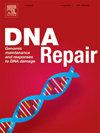U2OS细胞对低剂量极低剂量率γ辐射的DNA损伤反应
IF 2.7
3区 生物学
Q2 GENETICS & HEREDITY
引用次数: 0
摘要
细胞对低剂量和低剂量率电离辐射的DNA损伤反应(DDR)较弱,目前仍存在争议。可以通过将细胞暴露于低适应剂量(AD)和随后的高挑战剂量(CD)来研究这种反应,其中反应很强。本研究的目的是分析暴露于极低剂量率AD和高剂量率CD的细胞中的DDR,特别关注ATM激酶的作用。U2OS细胞(野生型p53)分别暴露在31µGy/h 5.9 mGy和55µGy/h 10.5 mGy的伽马辐射下。KU-55933对ATM有抑制作用。适应后的细胞以1 Gy/min的速度暴露于1 Gy光子辐射的CD中。研究终点包括53BP1病灶形成和衰减动力学、细胞周期进展和基因表达。在一些实验中,KU-55933对ATM有抑制作用。即使在存在KU-55933的情况下,AD也能显著增加53BP1的病灶,并调节对CD的反应。KU-55933不能抑制AD和AD+CD对病灶的诱导,而单独CD对病灶的诱导则被抑制。KU-55933增强了AD+ cd暴露细胞的G2阻滞。AD可调节基因表达。总之,在KU-55933不存在和不存在的情况下,AD单独给药和CD后给药对细胞反应的调节是不同的。本文章由计算机程序翻译,如有差异,请以英文原文为准。
DNA damage response of U2OS cells to low doses of gamma radiation delivered at very low dose rate
The DNA damage response (DDR) of cells to low dose and low dose rate ionizing radiation is weak and remains a matter of controversy. The response can be studied by exposing cells to a low adapting dose (AD) and, subsequently to a high challenging dose (CD), where the response is strong. The aim of the present investigation was to analyse the DDR in cells exposed to very low dose rate AD and a high dose rate CD, with special focus on the role of the ATM kinase. U2OS cells (with wild type p53) were exposed to gamma radiation AD of 5.9 mGy at 31 µGy/h and of 10.5 mGy at 55 µGy/h. ATM was inhibited by addition of KU-55933. Adapted cells were exposed to a CD of 1 Gy photon radiation at 1 Gy/min. The studied endpoints included kinetics of 53BP1 foci formation and decay, cell cycle progression and gene expression. In some experiments, ATM was inhibited by KU-55933. AD alone led to a significant increase in 53BP1 foci, even in the presence of KU-55933, and it modulated the response to CD. KU-55933 failed to inhibit the induction of foci by AD and AD+CD, while foci induction by CD alone was inhibited. KU-55933 potentiated the G2 block in AD+CD-exposed cells. Gene expression was modulated by AD. In conclusion, AD differentially modulated the response of cells when given alone and after the CD, in absence and presence of KU-55933.
求助全文
通过发布文献求助,成功后即可免费获取论文全文。
去求助
来源期刊

DNA Repair
生物-毒理学
CiteScore
7.60
自引率
5.30%
发文量
91
审稿时长
59 days
期刊介绍:
DNA Repair provides a forum for the comprehensive coverage of DNA repair and cellular responses to DNA damage. The journal publishes original observations on genetic, cellular, biochemical, structural and molecular aspects of DNA repair, mutagenesis, cell cycle regulation, apoptosis and other biological responses in cells exposed to genomic insult, as well as their relationship to human disease.
DNA Repair publishes full-length research articles, brief reports on research, and reviews. The journal welcomes articles describing databases, methods and new technologies supporting research on DNA repair and responses to DNA damage. Letters to the Editor, hot topics and classics in DNA repair, historical reflections, book reviews and meeting reports also will be considered for publication.
 求助内容:
求助内容: 应助结果提醒方式:
应助结果提醒方式:


